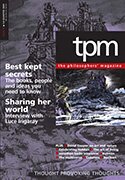Mat Iredale asks is political evolution like biological evolution?
 Have human societies evolved through a sequence of gradual increases in complexity, like the evolution of life, or have they emerged through larger, non-sequential increases? Some political philosophers, sociologists, archaeologists, anthropologists, and political scientists have argued that there are recurring patterns or processes in the way societies change over time, but others disagree. What is clear, according to the anthropologist Tom Currie of University College London, is that such debates have taken place largely in the absence of rigorous, quantitative tests; a failing which Currie and his team have recently tried to redress by evaluating six competing models of political evolution in Austronesian-speaking societies through the novel use of phylogenetics (the study of evolutionary relatedness).
Have human societies evolved through a sequence of gradual increases in complexity, like the evolution of life, or have they emerged through larger, non-sequential increases? Some political philosophers, sociologists, archaeologists, anthropologists, and political scientists have argued that there are recurring patterns or processes in the way societies change over time, but others disagree. What is clear, according to the anthropologist Tom Currie of University College London, is that such debates have taken place largely in the absence of rigorous, quantitative tests; a failing which Currie and his team have recently tried to redress by evaluating six competing models of political evolution in Austronesian-speaking societies through the novel use of phylogenetics (the study of evolutionary relatedness).
Evolutionary biologists have been using phylogenetic trees (constructed from genetic data) for years to test evolutionary hypotheses about such things as morphology, physiology, and behaviour, but it is only recently that anthropologists have begun to use cultural phylogenies to test hypotheses about human social and cultural evolution. Trees built using the similarities between basic vocabularies in different languages have been shown to be good indicators of population history. Currie believes that by mapping data about the characteristics of societies onto the tips of these trees, we can use phylogenetic comparative methods to make inferences about what societies were like in the past and how they have changed over time.
Some 5,000 years ago, Austronesian speakers from Taiwan spread through the Philippines into Indonesia, west to coastal southeast Asia and Madagascar, and east through the Pacific Ocean to evolve into Polynesians and colonize every habitable Pacific island from Hawaii and Easter Island to New Zealand. During this time Austronesian societies underwent spectacular political differentiation to give rise to examples of the entire range of political organization, from small egalitarian societies, through simple chiefdoms of Easter Island and New Zealand and the complex chiefdoms of Tahiti and Sumatra, to the comparatively complex Javan and Malagasy states. Given that over most of the Polynesian realm, the Austronesian people were the first human colonists, thereby decreasing the complexities associated with population mixing, and that the Austronesian language tree is densely filled out, with some 1,200 extant languages, the spread of Austronesian speakers provides an ideal data-set for their study.
One of Currie’s co-authors, the evolutionary biologist Russell Gray, has been able to create phylogenetic trees showing the historical relationships between Austronesian societies using basic vocabulary data by applying the same techniques that biologists use with genetic data to infer the shared ancestry of species. The range of forms of political organisation in these societies in conjunction with the knowledge of their ancestral relationships enabled Currie, Gray and the rest of the team to test competing hypotheses of the evolution of political organization.
They defined levels of political complexity by the number of hierarchical decision-making levels, which accords with traditional social evolutionary classifications: “societies lacking permanent leadership beyond the local community are labelled ‘acephalous’; those with a single level beyond the local community are labelled ‘simple chiefdoms’; those with two levels represent ‘complex chiefdoms’; and societies with more than two levels are ‘states’.” They then evaluated six different models for the evolution of political organization taken from discussions in the relevant literature.
Three of these models reflect a defining feature of traditional social evolutionary theory that political evolution has proceeded through a sequence of incremental increases in hierarchical complexity. In each of these models, say the authors, “it is possible for societies to change from an acephalous form of organization to a simple chiefdom, from a simple chiefdom to a complex chiefdom, or from a complex chiefdom to a state. However, the direct transitions from acephalous to complex chiefdom, acephalous to state, and simple chiefdom to state cannot occur.”
One of the three, the rectilinear model, reflects the extreme view that although societies may pass through the forms of increasing political complexity sequentially, decreases in hierarchical organization cannot occur. The unilinear model allows sequential decreases to adjacent less hierarchical forms of organization and the relaxed unilinear model allows decreases to any less hierarchical form.
In contrast, the other three models represent the idea that the evolution of increasing hierarchical political organization has not been sequential. According to each of these models, it is possible for societies to change directly from an acephalous form to a simple chiefdom, or directly to a complex chiefdom, or directly to a state. As with the first three models, they differ in how they allow decreases in hierarchical organization. According to the alternate trajectories model, decreases in hierarchical organization cannot occur (as with the rectilinear model). The alternative trajectories (reversible) model states that both increases and decreases are non-sequential. The final model, termed the full model, holds that any change in political organization is possible – acephalous to state, state to simple chiefdom, complex chiefdom to acephalous, and so on – reflecting the idea that political evolution has been completely unconstrained.
Currie and his team then tested the models using two statistical modelling techniques, Maximum likelihood estimation (MLE) and the wonderfully named Reversible jump Markov chain Monte Carlo method (RJMCMC). According to the authors, “both techniques estimate the probable rates of change between different forms of organization over the phylogenetic trees given the distribution of data at the tips of the trees. Performing the analyses over a sample of trees allows us to take into account the uncertainty about the historical relationships between Austronesian societies.”
In both the ML and RJMCMC analyses they discovered that the unilinear model is the best supported, closely followed by the relaxed unilinear model. The full model was ranked third but there was evidence against it from the RJMCMC analysis. The other three models – alternative trajectories, alternative trajectories (reversible), and rectilinear – received no support from the RJMCMC analyses.
Jared Diamond, author of Guns, Germs, and Steel: The Fates of Human Societies, states that the results of the research are clear: “First, political evolution increases only in small steps: states and complex chiefdoms don’t form directly from leaderless societies…Second, political complexity can decrease as well as increase, in agreement with abundant evidence of the disintegration of states and chiefdoms. Finally, unlike increases of complexity, declines can plunge a society politically several stages backwards.”
Diamond notes that the modelling techniques used by Currie et al have “previously received little application to the problem of the evolution of political complexity.” And therein lies a problem, as the anthropologist Robert Carneiro of the American Museum of Natural History in New York admits: “Their objective is anthropological. But their method is entirely different to anything we’ve ever used. Even supposing I knew these statistical techniques, just how you get from a linguistic phylogeny to political evolution, I don’t know.”
Diamond acknowledges that the team’s research required huge quantities of data and technical knowledge: “lists of 210 vocabulary terms for more than 500 Austronesian languages, ethnographic information on the political complexity of 113 Austronesian societies, and mastery of the notorious difficulties of phylogenetic-tree construction and model evaluation.” But he clearly believes that such approaches are necessary to take our understanding of political evolution to the next level: “Almost all of us in this field (myself included) have instead proceeded usually by narrative accounts of individual cases, less often by narrative comparisons of selected cases, and infrequently by comprehensive narrative surveys.”
But as Currie and his team point out, their analyses “move us beyond purely verbal arguments, statistically assessing support for different models of political evolution, and finding models with incremental increases in hierarchical organization to be the best supported by the data. This study highlights the benefits of applying the same kinds of techniques used to study complex systems in nature to investigate long-term human social and cultural evolution. Interestingly, these results indicate that political evolution, like biological evolution, tends to proceed through small steps rather than through major jumps in “design space”.
Suggested Reading:
Rise and fall of political complexity in island South-East Asia and the Pacific by Thomas Currie, Simon Greenhill, Russell Gray, Toshikazu Hasegawa & Ruth Mace, Nature 467, pp 801–804 (14 October 2010)
Political Evolution by Jared Diamond, Nature 467, pp 798–799 (14 October 2010)
Language Phylogenies Reveal Expansion Pulses and Pauses in Pacific Settlement by Russell Gray, Alexei Drummond and Simon Greenhill, Science 323, pp. 479-483 (23 January 2009)
Mathew Iredale’s Sci-Phi column appears every issue in tpm. Read them as soon as they are published by subscribing to the magazine
 Email This Post
Email This Post 



[...] Mat Iredale asks to what extent “political evolution” is similar to the theory of evolution in biology. [...]